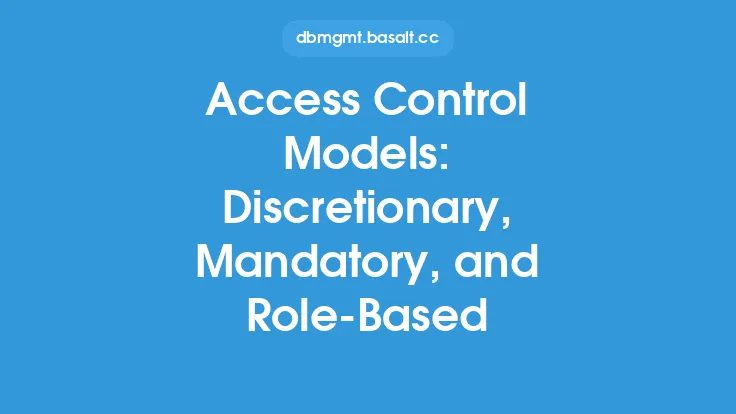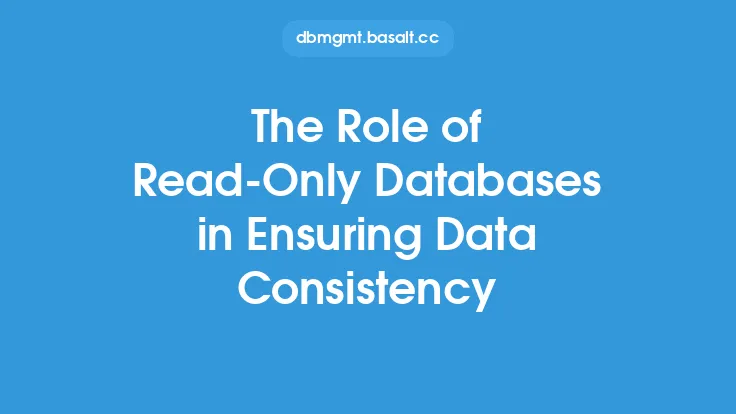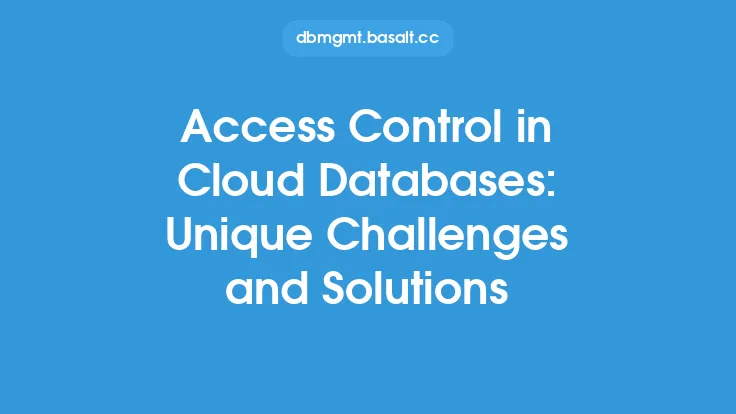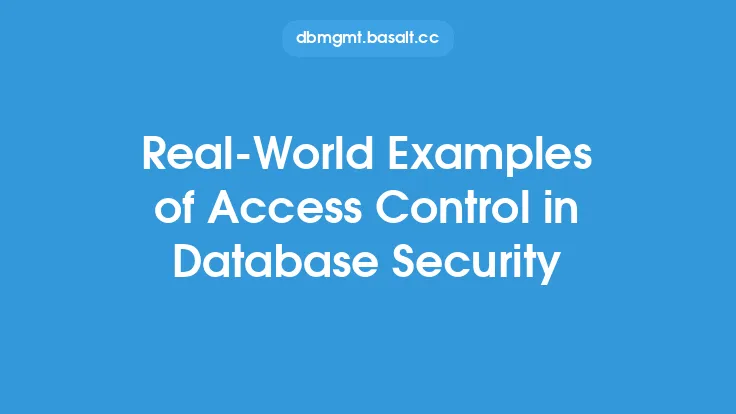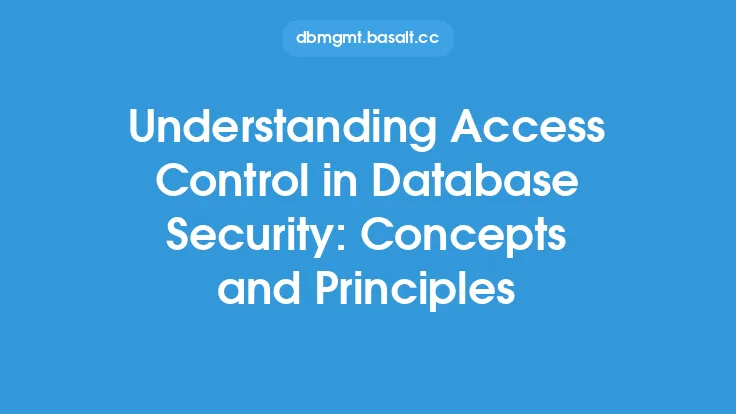Implementing role-based access control (RBAC) in databases is a crucial aspect of database security, as it enables organizations to manage access to sensitive data and ensure that users can only perform actions that are necessary for their job functions. RBAC is a widely accepted and effective approach to access control, as it provides a flexible and scalable way to manage access to database resources.
Introduction to Role-Based Access Control
Role-based access control is a security approach that assigns users to roles, which are then associated with specific permissions and access rights. This approach is based on the principle that users should only have access to the data and resources that are necessary for their job functions. In a database context, RBAC involves creating roles that define the actions that users can perform on database objects, such as tables, views, and stored procedures.
Benefits of Role-Based Access Control
The benefits of implementing RBAC in databases are numerous. Some of the key advantages include:
- Improved security: RBAC ensures that users can only access data and perform actions that are necessary for their job functions, reducing the risk of unauthorized access and data breaches.
- Simplified access management: RBAC makes it easier to manage access to database resources, as administrators can simply assign users to roles rather than having to manage individual permissions.
- Increased flexibility: RBAC allows organizations to define custom roles that meet their specific needs, making it easier to adapt to changing business requirements.
- Better auditing and compliance: RBAC provides a clear audit trail of user activity, making it easier to demonstrate compliance with regulatory requirements.
Key Components of Role-Based Access Control
There are several key components of RBAC that are essential for implementing an effective access control system. These include:
- Roles: A role is a collection of permissions and access rights that define the actions that a user can perform on database objects.
- Users: A user is an individual who is assigned to one or more roles, and who has the permissions and access rights associated with those roles.
- Permissions: A permission is a specific right or privilege that is granted to a role, such as the ability to select, insert, update, or delete data.
- Role hierarchies: A role hierarchy is a structure that defines the relationships between roles, with more senior roles inheriting the permissions and access rights of junior roles.
Implementing Role-Based Access Control in Databases
Implementing RBAC in databases involves several steps, including:
- Defining roles: The first step in implementing RBAC is to define the roles that will be used to manage access to database resources. This involves identifying the different job functions and responsibilities within the organization, and creating roles that align with these functions.
- Assigning users to roles: Once the roles have been defined, the next step is to assign users to these roles. This involves identifying the users who will be performing each job function, and assigning them to the corresponding role.
- Defining permissions: The next step is to define the permissions that will be associated with each role. This involves identifying the specific actions that users in each role should be able to perform on database objects, and granting the necessary permissions.
- Creating role hierarchies: Finally, the last step is to create role hierarchies that define the relationships between roles. This involves identifying the more senior roles that should inherit the permissions and access rights of junior roles.
Database Management System Support for Role-Based Access Control
Most modern database management systems (DBMS) provide support for RBAC, including:
- Oracle: Oracle provides a robust RBAC system that allows administrators to define roles, assign users to roles, and grant permissions.
- Microsoft SQL Server: SQL Server provides a RBAC system that allows administrators to define roles, assign users to roles, and grant permissions.
- IBM DB2: DB2 provides a RBAC system that allows administrators to define roles, assign users to roles, and grant permissions.
- PostgreSQL: PostgreSQL provides a RBAC system that allows administrators to define roles, assign users to roles, and grant permissions.
Best Practices for Implementing Role-Based Access Control
There are several best practices that organizations should follow when implementing RBAC in databases, including:
- Keep it simple: RBAC systems can become complex and difficult to manage if there are too many roles and permissions. Organizations should strive to keep their RBAC systems simple and easy to understand.
- Use a least privilege approach: Organizations should follow a least privilege approach when granting permissions, ensuring that users only have the permissions and access rights that are necessary for their job functions.
- Regularly review and update roles: Organizations should regularly review and update their roles and permissions to ensure that they remain aligned with changing business requirements.
- Use auditing and logging: Organizations should use auditing and logging to monitor user activity and detect any potential security breaches.
Common Challenges and Limitations of Role-Based Access Control
While RBAC is a widely accepted and effective approach to access control, there are several common challenges and limitations that organizations may encounter, including:
- Complexity: RBAC systems can become complex and difficult to manage, particularly in large and distributed environments.
- Scalability: RBAC systems can be difficult to scale, particularly in environments with large numbers of users and roles.
- Flexibility: RBAC systems can be inflexible, making it difficult to adapt to changing business requirements.
- Integration: RBAC systems can be difficult to integrate with other security systems and technologies, such as identity and access management (IAM) systems.
Future Directions for Role-Based Access Control
The future of RBAC is likely to involve the integration of new technologies and approaches, such as:
- Artificial intelligence (AI) and machine learning (ML): AI and ML can be used to improve the efficiency and effectiveness of RBAC systems, particularly in large and complex environments.
- Cloud computing: Cloud computing is likely to play a major role in the future of RBAC, particularly in terms of providing scalable and on-demand access to database resources.
- Internet of Things (IoT): The IoT is likely to drive the need for more advanced and flexible RBAC systems, particularly in terms of managing access to large numbers of devices and sensors.
- Big data: Big data is likely to drive the need for more advanced and scalable RBAC systems, particularly in terms of managing access to large volumes of data.
